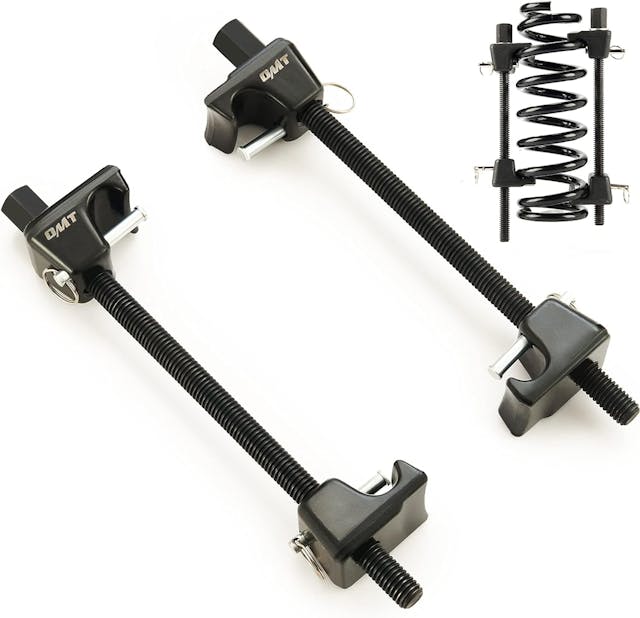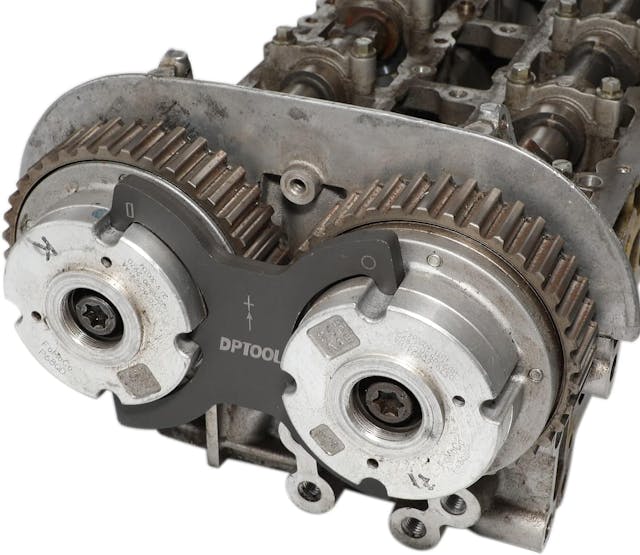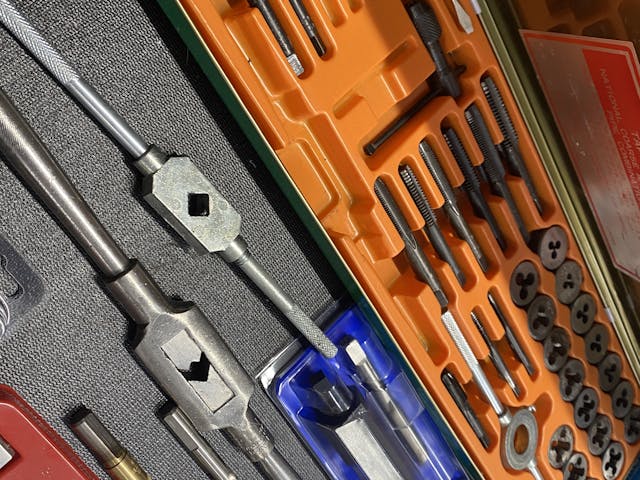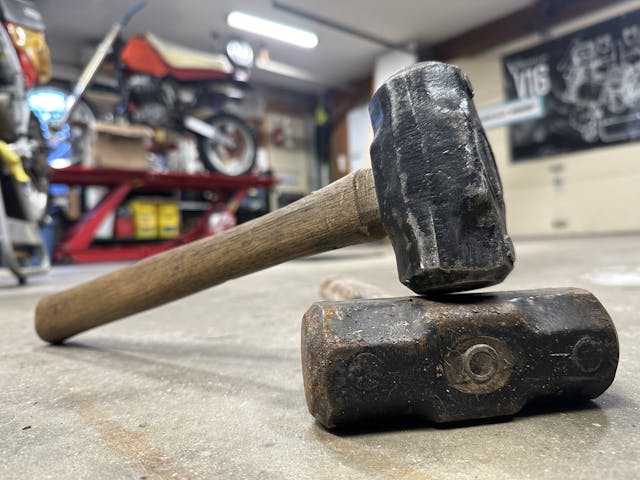Media | Articles
6 Tools We Hate to Reach For
Most of us treasure the time we spend working on projects. The mental flow state that comes with forcing our minds to mellow out and focus on solely the task at hand can be therapeutic—in the right situation. Every bright light casts a shadow, and every garage holds some tools we hope never to use.
These are the devices that mean our time in the garage is not going well. The steel canaries in the horsepower mine. Projects go sideways just as many times as they go flawlessly, and many of us have various gadgets that serve no purpose until all else has failed.
Here are a few tools that we love to have but hate to reach for.
Tool #1: Tap set
More often than not, forming—or re-forming—threads in a part or piece follows the destruction of those spiraling channels. You’ve probably broken a piece of hardware—or, worst of all, an easy-out. Toss in the fact that taps are very hard, and thus brittle, and you have a very volatile evening of work ahead of you.
When used properly and carefully, a tap set can be a reset button on the life of a part. Even drilling up one size and tapping so that a fastener can have appropriate holding power may be better than replacing the fastener. Sometimes it’s all about perspective.
Marketplace
Buy and sell classics with confidence
Tool #2: Spring compressors

The sudden release of potential energy describes a lot of scenarios: The explosion of a firecracker, the expansion of an airbag, and the release of a compressed spring. Each of those can have serious long-term health effects if it happens too close to your person. There are two groups of people who work on automotive suspension: those who are uncomfortable, and those who ignore the forces at play.
Springs and suspension still need to be serviced, though. Carefully inspect and service spring compressors before using them to ensure there is no damage or problems that might pop up. Sometimes just that bit of added confidence is enough to soften the fear factor.
Tool #3: Camshaft locker

It’s not that this tool is so bad; it’s that the consequences of human error when using it are high enough to make us uneasy. Variable camshaft timing has unlocked horsepower that comes with minimal compromises in fuel economy and also drivability. Unfortunately, the technology also makes for more complicated service; replacing a timing chain or belt often requires careful alignment of multiple points while also holding tensioners and gears in proper orientation. The job can be fairly painless, but that doesn’t mean it’s fun.
Tool #4: Air hammer

Percussive force breaks the bonds of rust, and it hammers eardrums just as thoroughly. The compromise can often be easily overcome with a good set of earplugs or over-the-ear muffs, but using an air hammer still isn’t a pleasurable experience. Compared to using the torch, and the chance of lighting everything on fire, it is the lesser of two evils. We don’t love you, air hammer, but, after all these years, we haven’t let you leave the toolbox.
Tool #5: Impact driver
Stripped hardware is the bane of any DIYer’s existence. Even with the proper tools and experience to handle stripped screws and bolts, we don’t want to spend the limited time we have in the garage dealing with them. The combination of driving and turning force delivered by an impact screwdriver can take quickly solve the problem of a partially stripped screw. It can also result in hitting your wrist with a hammer, or create an even bigger problem by snapping a bolt off where you can’t grab it. Often, our opinion of an impact screwdriver is based on how well it worked the last time we used it.
Tool #6: The Big Hammer
You know the one. The handle is slightly stained, and the face features a few chips from that one time you got a little carried away on that ball joint. You probably started addressing the problem at hand with a couple of smaller hammers and, when you realized that things were not going your way, and that you were tired of talking nice, opened the drawer to grab The Big Hammer.
This list is all a matter of opinion and personal experience, so we may have missed one or two here. If you’ve got a tool you avoid reaching for but might not be able to put a finger on why, leave a comment. Consider it an unofficial survey.
***
Check out the Hagerty Media homepage so you don’t miss a single story, or better yet, bookmark it. To get our best stories delivered right to your inbox, subscribe to our newsletters.










My most dreaded tool is my neighbor. If I need him, I definitely screwed something up. And, more times than not the bigger mistake was asking him to help. I have sockets in my frame to prove it.
Oh, I forgot, he knows everything
Flaring tool because it usually means I will be working on rusted brake lines. Did I ever tell you how much I hate brake lines? If only manufacturers produced them with stainless steel…
Judging by some of these responses, I am reminded as to why my shop was so busy “un-fudging” things on most of our walk-in traffic. Beginning with my grandfather in 1927, then on to my dad and uncle until 1980 when I took over until we closed in 2017, there was always something that required repair after having been worked on by persons unqualified to do so. Most of these corrective actions were due to a lack of knowledge and failure to pay attention to either the part (as in replace it before it fails) or a total lack of regard for the tool(s) used to fudge it up. Oh well, those folks made it possible for us to stay fed and healthy. By the way, we were never intimidated by a broken threaded fastener. That’s why Helicoils and Timeserts were invented…
I have all those tools. My initial go-to is almost always the BFH. The tools I really hate are the ones I have and need but can’t find….
I don’t know why anyone would hate to go to any of those tools. When I need it I thank God I had it, and for all the other tools I have. Without tools, we couldn’t do anything, love them things.
I think you missed the point of the story. It’s not saying we hate the tools listed, the story is about hating the situation that requires us to have use the tools listed.
Why, Kyle—These are THE VERY Tools which I most cherish–not fear! I cannot count the times that such “last resort” Tools have saved my life–I know exactly where each one is located in my shop so that I do not have to search for it! I DO agree with the persons who comment about buying cheap tools which are going to fail a guy just when he most needs them. “Harbor Freight” quality Tools may be okay for some people–but I can boast of Tools which have lasted for YEARS–no need to replace them from time to time! And…I have Tools which are strong enough so that, if necessary, I can use my “cheater pipes”! LOL
The only one of those tools that I fear is the spring compressor. I do most stuff myself but I usually have a shop deal with springs on struts. However, the last shop that I had do them neglected to tighten the nut holding the top mount on the strut, so I still have to check the work that I am paying to have done.
The worst tool to reach for……the one that fell into the oil drain bucket……
How about the one that rolled along the fender liners under the headlights, under the intake,or at the base of the cowl?
These are all normal tools for normal jobs. Not an issue using them. The ones I hate: EZ-Outs>>broke one in an underbody bumper bracket hole>>never got it out. Don’t like Picl forks>>they tear the grease boots. Torch>>always a risk of setting something else on fire or dropping a hot spark down your neck.
If I need an acetylene torch, the day went bad
Assuming I’m not on a deadline, my “last resort” tool is a bottle of Cabernet.
I always find that when things get bad it’s often better to walk away and sleep on it.
Doesn’t work 100% of the time but I can’t tell you how many times I came back the next day with a totally different perspective and got the job done easier than I thought it would be.
Slide hammer: wonderful, indispensable tool unless it can’t do the job by itself, and must be helped along with heat, penetrating oil, and Fijian curse words.
The tap/die rethreading drawer is one of the most frequently accessed in my shop. I have both SAE and Metric and some are remarkably close. When a fastener will not run on with my fingers, I open the drawer rather than just forcing it. Buggered threads? Metric rather than SAE? I have found many fasteners forced together and just shake my head when I do. It’s so simple to confirm the thread with a gauge, or clean up a dodgy thread. Beats stripping or breaking a bolt every time!
Couple of ideas. Many times people use a tap when what ought to be used is a chase. Removing material that needs not be removed works to get the threads going again, but a chase many times is more appropriate. In my younger days, when I was a lot more impetuous, a guy I wrenched with told me this ‘hint’ he got from an old timer. He said when you are trying to get something apart, take your time, penetrating oil, heat, carefully in-out, back forth but go slow, lots more oil, clean what threads you can get to. The driving question is……would you rather take 20 minutes of slow work to unscrew something, or take 30 seconds to break it, then drill it out, attempt to retap the threads after trying to find the right size drill bit, break the tap……. Going slow does not always work, but unthreading something is way more gratifying than snapping it off.
I may just print this advice off and tape it to my drawer that holds taps and E-Z outs. Now, If I can only remember to follow it the next time I’m cussing and yanking that drawer open in order to hastily “correct” an issue so I can get on with things! 😉
As I have, let’s say, aged gracefully, I take a similar cost/benefit approach to safety. Before I try bouncing the step ladder a foot or two to the side, I ask myself…..let’s see, I can go down the ladder, move it, take 30 seconds or so, or bounce it across the floor. If it goes well, great. If I fall off, hummmm…. maybe a broken ankle? arm? wrist? whatever, and a trip to the Emergency room, at least several weeks recovery, I think my E-room co-pay these days is $100….and worst of all……the ‘supervisor’ will not easily let the incident go.
Cutting torches, last resort to get things apart, because of the collateral damage.